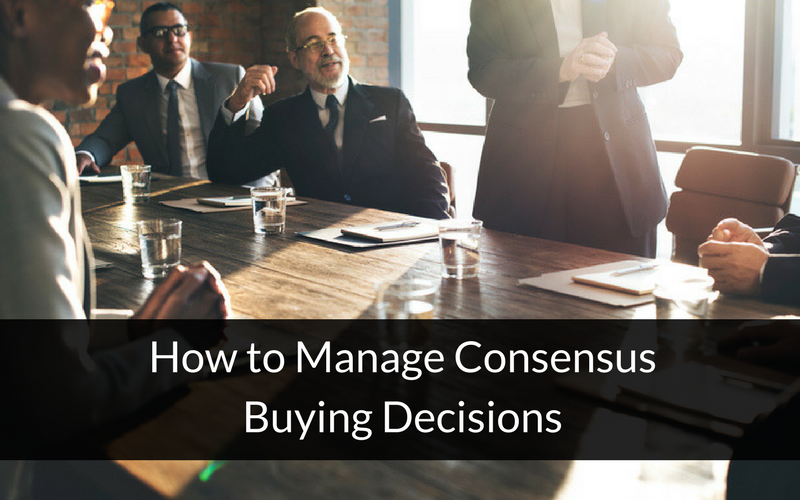
No longer can a single executive make buying decisions on behalf of the entire company. According to a survey by CEBGlobal, the average number of people required to make a B2B purchase has risen to 5.4.
As a seller, you need to convince more than five people, all with different agendas and priorities, that your solution is the one to buy. You also need to keep in mind that each of those 5.4 people can have veto power over organizational purchases.
Consensus is not built easily. It typically requires someone to bring the factions together: a facilitator, if you will. That facilitator must be you, the sales executive.
Larger buying groups have increased the cycle time for sales. You are the one who cares the most about the timing of the completed sale. And you are the one who must learn to function as a B2B vendor in today’s climate of extreme caution in purchasing.
Who Could Be Involved in a B2B Buying Decision?
More than five people from the list below are expected to say “yea” or “nay” to your product:
- C-Level Executive
- Business Buyer
- Financial Executive
- IT Leaders
- Marketing
- Operations
- Procurement
- Strategist
And if you don’t get all five to say “yea”, you’re likely to end up with no decision.
In addition to the buying committee, you also have to deal with influencers, including:
- Purchasing departments
- End users
- Gatekeepers
- A sponsor or champion
- Researchers
Taking special note of that last bullet, more than 80% of B2B companies go looking for vendors, and are more than halfway through the buying process before you even know they’re looking.
Also, keep in mind that the most important influencer of the buying committee is the financial officer. If finance isn’t convinced, your sale is dead in the water.
Why Consensus Fails
Often, consensus has already failed by the time your sales rep is called to the scene. The members of the purchasing committee may not be well-coordinated or may not be able to come to an agreement on the definition of the problem or what direction to take to resolve it.
The greatest hurdle to consensus is the sense of fear stakeholders have for themselves and their own positions.
Half are afraid they’ll lose respect or credibility within the organization if they make the wrong decision. They dread the consequences of having actively advocated or signed-off on a product or service that doesn’t meet the intended business needs of the company or comes with hidden costs.
Others fear being associated with the selection of a product or service that doesn’t deliver as expected, even if they spoke against the selection. If they didn’t directly veto the selection altogether, a poor decision can haunt their career prospects or position.
The bigger the team, the more fear you have to overcome.
Managing Consensus
As a B2B value seller, you must see that it’ll take more than a sales team to win the deal. The prospect’s search typically begins well before a sales rep is called. Marketing must work the top of the funnel, providing engaging content that compels prospects to move deeper into the buyer’s journey.
Check out these 8 tips to becoming a better B2B marketer
Along the way, prospects must be persuaded to disclose relevant data and insights into their company’s business challenges and objectives so that you can first confirm that you can help them achieve their goals, and then determine the best way to introduce your solution. By the time prospects become sales-qualified leads, your sales team should be armed with enough information to actively engage in the selling process.
The Role of Value Selling Tools
Value-selling tools that allow prospects to define their problems using their own data are the ideal hooks for generating leads. Assessment tools and value calculators can provide prospects with valuable insights into the extent of their issues, and how they compare to competitors or measure up to industry benchmarks. In return, these tools can provide you with valuable data to use as the foundation of a business case for your prospect.
Once a sales rep engages with the customer, the consensus must be rebuilt if it has faltered or appears to be stumbling. Even a consensus that is on track requires the skills of a good sales conductor to keep the train moving in the right direction.
As mentioned previously, each member of the buying group has a different set of priorities. Finance typically has the most powerful voice in the room, but others still have veto power. Note that many non-finance members can be convinced with the right data.
You may be asked to prove your solution against a competitor or an alternative process. Using a Total Cost of Ownership (TCO) tool can show that initial pricing isn’t the best way to select a solution. If you’re armed with the right data, you should now easily be in a position to tie up the sale with the finance officer whose primary concern is numbers.
Last but not least, providing a defendable ROI provides the financial justification for making an investment in the best solution to address the clearly defined problems, with the knowledge that it’s more cost effective than the alternative.
Conclusion
Getting a committee to agree on a solution requires confirming that everyone is on the same page regarding the business issues that need to be tackled, and then providing the data to address each member’s concerns. This will keep your sale moving in the right direction. With a full set of value-selling tools, you’ll be well prepared to effectively manage consensus and win the deal.
Show finance the return on investment along with the rest of the business case and you’ll l successfully achieve consensus with the 5.4 members of the purchasing group.















